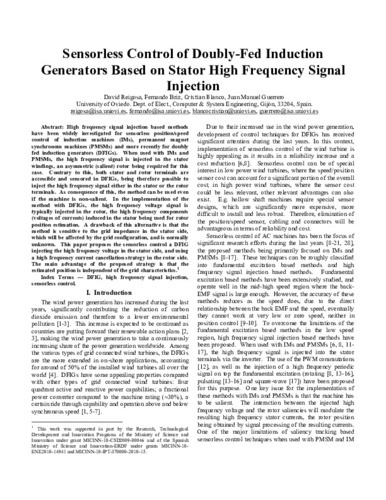Sensorless control of doubly fed induction generators based on stator high-frequency signal injection
Publication date:
Editorial:
IEEE
Publisher version:
Citación:
Descripción física:
Abstract:
High-frequency-signal-injection-based methods have been widely investigated for sensorless position/speed control of induction machines (IMs), permanent magnet synchronous machines (PMSMs), and, more recently, doubly fed induction generators (DFIGs). When used with IMs and PMSMs, the high-frequency signal is injected in the stator windings, an asymmetric (salient) rotor being required for this case. Contrary to this, both stator and rotor terminals are accessible and sensored in DFIGs, being therefore possible to inject the high-frequency signal either in the stator or the rotor terminals. As a consequence of this, the method can be used even if the machine is nonsalient. In the implementation of the method with DFIGs, the high-frequency voltage signal is typically injected in the rotor, the high-frequency components (voltages of currents) induced in the stator being used for rotor position estimation. A drawback of this alternative is that the method is sensitive to the grid impedance in the stator side, which will be affected by the grid configuration, and is normally unknown. This paper proposes the sensorless control of a DFIG injecting the high-frequency voltage in the stator side and using a high-frequency current cancellation strategy in the rotor side. The main advantage of the proposed strategy is that the estimated position is independent of the grid characteristics
High-frequency-signal-injection-based methods have been widely investigated for sensorless position/speed control of induction machines (IMs), permanent magnet synchronous machines (PMSMs), and, more recently, doubly fed induction generators (DFIGs). When used with IMs and PMSMs, the high-frequency signal is injected in the stator windings, an asymmetric (salient) rotor being required for this case. Contrary to this, both stator and rotor terminals are accessible and sensored in DFIGs, being therefore possible to inject the high-frequency signal either in the stator or the rotor terminals. As a consequence of this, the method can be used even if the machine is nonsalient. In the implementation of the method with DFIGs, the high-frequency voltage signal is typically injected in the rotor, the high-frequency components (voltages of currents) induced in the stator being used for rotor position estimation. A drawback of this alternative is that the method is sensitive to the grid impedance in the stator side, which will be affected by the grid configuration, and is normally unknown. This paper proposes the sensorless control of a DFIG injecting the high-frequency voltage in the stator side and using a high-frequency current cancellation strategy in the rotor side. The main advantage of the proposed strategy is that the estimated position is independent of the grid characteristics
ISSN:
Patrocinado por:
This work was supported in part by the Research, Technological Development and Innovation Programs of the Ministry of Science and Innovation under grant MICINN-10-CSD2009-00046 and of the Spanish Ministry of Science and Innovation-ERDF under grants MICINN-10- ENE2010-14941 and MICINN-10-IPT-370000-2010-15
Collections
Files in this item




